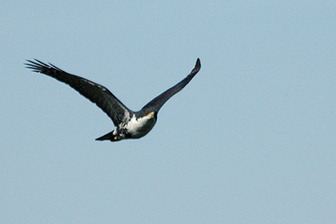Black Goshawk

Original source: Own work
Author: Tom TarrantPermission(Reusing this file)Attribution ShareAlike 3.0
The Black Goshawk is classified as Least Concern. Does not qualify for a more at risk category. Widespread and abundant taxa are included in this category.
Black Goshawk is mainly black, but with variable amount of white below, ranging from almost entirely white, to black except for a white throat and undertail coverts. Juveniles are browner and have streaks to the underparts. The cere and legs are yellow. References - 1. ^ BirdLife International (2008). Accipiter melanoleucus. In: IUCN 2008. IUCN Red List of Threatened Species. Downloaded on 19 February 2009. More
The largest of the African Accipiter species, the black goshawk is a distinctive bird of prey with conspicuous black and white plumage, rounded wing tips and a long tail (2). Although the adult plumage is generally black above and white below, there is considerable variation in patterning between individuals. Most commonly, the breast is white with black blotches and speckling along the flanks and thighs and sometimes across the belly, but some individuals are entirely black except for a white patch around the throat (2) (4). More
There are currently two recognised subspecies of black goshawk, which occupy different regions within this species’ extensive range. Accipiter melanoleucus temminckii is found from Senegal, eastwards to Gabon, Congo and Central African Republic, while Accipiter melanoleucus melanoleucus occurs in eastern Sudan and north-west Ethiopia, as well as in much of Central and southern Africa (4). More
The plumage of the Black Goshawk is mostly black, but with variable amount of white below, ranging from almost entirely white, to black except for a white throat and undertail coverts. Juveniles are browner and have streaks to the underparts. The cere and legs are yellow. More

Original source: Tom Tarrant
Author: Tom Tarrant
Permission: Some rights reserved
Family : Accipitridae
Genus : Accipiter
Species : melanoleucus
Authority : Smith, 1830

